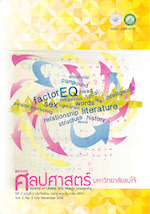โครงสร้างของคำประสมที่มีคำว่า “หัว” ในภาษาไทลื้อ (The Structure of the Compound Words Containing “Head” in Tai Lue Language)
Main Article Content
Abstract
การวิจัยครั้งนี้ได้เก็บรวบรวมข้อมูลจากเอกสารอักษรไทลื้อ ซึ่งเป็นเอกสารจากสิบสองพันนา มณฑลยูนนาน ประเทศจีน แบ่งออกเป็น 9 ประเภท ได้แก่ เอกสารประวัติศาสตร์ จารีตประเพณี วรรณกรรม นิทาน ตำรา แบบเรียน สุภาษิต บทเพลง และหนังสือพิมพ์
ผลการวิจัยพบว่า คำประสมที่มีคำว่า “หัว” ในภาษาไทลื้อ จำนวน 106 คำ สามารถแบ่งโครงสร้างออกเป็น 2 กลุ่ม กลุ่มแรก ได้แก่ โครงสร้างชั้นเดียว กลุ่มที่ 2 ได้แก่ โครงสร้างหลายชั้น ซึ่งอาจเป็นโครงสร้าง 2 ชั้น โครงสร้าง 3 ชั้น หรือโครงสร้าง 4 ชั้น
This study aims to examine the structure of the compound words containing “head” (or hua in Thai) in Tai Lue Language. The theoretical framework is based on an immediate constituent analysis by Leonard Bloomfield.
The data is collected from the documents in Tai Lue alphabets found in Xishuangbanna, Yunnan District, China. The documents are divided into nine types namely historical documents, customary documents, literatures, tales, books, textbooks, proverbs, songs and newspapers.
From this study, the results reveal that there were 106 compound words containing “head” classified into two main groups of the structures. The first group is composed of a single-level structure, and the second group with multi-level structures including two, three and four levels.

